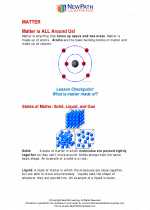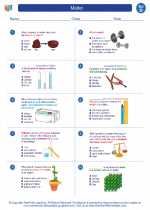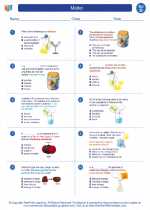Charles's Law
Charles's Law states that the volume of a gas is directly proportional to its temperature, when pressure and amount of gas are held constant. In simpler terms, as the temperature of a gas increases, so does its volume, and as the temperature decreases, the volume also decreases.
Key Concepts:
- Volume: The amount of space that a gas occupies.
- Temperature: The measure of the average kinetic energy of the gas particles.
- Proportional: When one value increases or decreases, the other value changes in the same direction by a constant factor.
Mathematical Representation:
Charles's Law can be mathematically represented as:
V1 / T1 = V2 / T2
Where:
- V1 = Initial volume of the gas
- T1 = Initial temperature of the gas (in Kelvin)
- V2 = Final volume of the gas
- T2 = Final temperature of the gas (in Kelvin)
Example Problem:
If a gas has an initial volume of 2 liters at a temperature of 300 K, what will be its volume when the temperature is increased to 400 K?
Using Charles's Law formula:
2L / 300K = V2 / 400K
Solving for V2:
V2 = (2L * 400K) / 300K
V2 = 2.67 liters
So, the volume of the gas will be 2.67 liters when the temperature is increased to 400 K.
Study Guide:
Here are some key points to remember about Charles's Law:
- Temperature must be in Kelvin when using Charles's Law.
- As temperature increases, volume increases, and vice versa.
- Pressure and amount of gas must remain constant for Charles's Law to be applicable.
- Charles's Law can be graphically represented as a straight line when volume is plotted against temperature at a constant pressure.
Hope this helps! Let me know if you have any more questions.
.◂Science Worksheets and Study Guides Fourth Grade. Matter
Study Guide Matter
Matter  Worksheet/Answer key
Worksheet/Answer key Matter
Matter  Worksheet/Answer key
Worksheet/Answer key Matter
Matter  Worksheet/Answer key
Worksheet/Answer key Matter
Matter  Worksheet/Answer key
Worksheet/Answer key Planning Pinwheel
Planning Pinwheel  Vocabulary/Answer key
Vocabulary/Answer key Matter
Matter  Vocabulary/Answer key
Vocabulary/Answer key Matter
Matter 

 Worksheet/Answer key
Worksheet/Answer key
 Worksheet/Answer key
Worksheet/Answer key
 Worksheet/Answer key
Worksheet/Answer key
 Worksheet/Answer key
Worksheet/Answer key
 Vocabulary/Answer key
Vocabulary/Answer key
 Vocabulary/Answer key
Vocabulary/Answer key

The resources above cover the following skills:
Concepts of Physical Science (SB1, SB2, SB3, SB4)
The student demonstrates an understanding of the structure and properties of matter by identifying and comparing the characteristics of gases, liquids, and solids.
Concepts of Physical Science: A student should understand and be able to apply the concepts, models, theories, universal principles, and facts that explain the physical world. A student who meets the content standard should:
Develop an understanding of the interactions between matter and energy, including physical, chemical, and nuclear changes, and the effects of these interactions on physical systems.